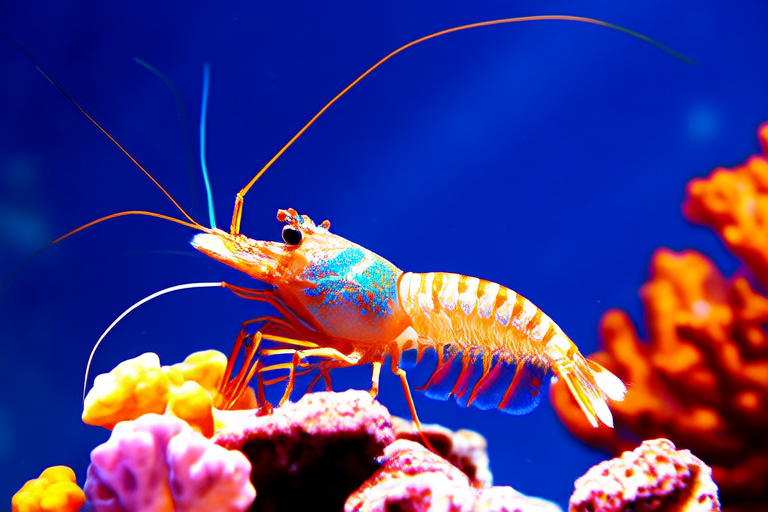Coral Shrimp Species Diversity: An In-depth Guide
Coral shrimp, also known as Stenopus hispidus, are among the most vibrant and captivating creatures that can be found in saltwater aquariums. These tiny crustaceans come in a variety of stunning colors and sizes, making them a popular choice for marine hobbyists. This comprehensive guide will introduce you to the diversity of coral shrimp species, their vibrant colors and sizes, ideal aquarium setup requirements, diet and feeding habits, care tips, common health issues, compatibility with other tank inhabitants, breeding behaviors, maintenance tips, and the benefits of keeping coral shrimp in your aquarium.
Diversity of Coral Shrimp Species
Coral shrimp belong to the family Stenopodidae, which comprises several genera and species. The most commonly kept species in the aquarium trade is Stenopus hispidus, but there are other species worth mentioning, such as Stenopus spinosus and Stenopus scutellatus. Each species has its unique characteristics, including coloration and size.
Vibrant Colors and Sizes
Coral shrimp are known for their striking coloration, which often includes shades of red, orange, yellow, and white. Their bodies are typically elongated, with distinct markings that make them easily recognizable. The Stenopus hispidus species, for instance, features a bright red body with white spots, while Stenopus spinosus has a more subdued brownish-red hue. The size of coral shrimp can vary, but they generally range from 1.5 to 3 inches in length.
Ideal Aquarium Setup Requirements
To ensure the well-being of coral shrimp, it’s essential to create an environment that closely mimics their natural habitat. Start by selecting a suitable aquarium size; a minimum of 30 gallons is recommended for a single shrimp, but larger tanks are preferable for groups or when combined with other species. Use live rock and corals to provide hiding places and a sense of security. Ensure proper water parameters, including temperature (72-78°F), pH (8.1-8.4), and salinity (specific gravity of 1.023-1.025).
Water Flow and Lighting
Provide moderate water flow to mimic the currents found in their natural environment. Additionally, ensure adequate lighting to support the growth of beneficial algae and microorganisms on which coral shrimp feed. Consider using a protein skimmer to maintain water quality and reduce the risk of ammonia spikes.
Diet and Feeding Habits
Coral shrimp are omnivorous scavengers, meaning they consume both plant and animal matter. In the wild, they primarily feed on detritus, algae, and small invertebrates. In captivity, they will eat leftover food, algae, and decaying organic matter. To supplement their diet, offer a varied menu of high-quality marine foods, such as frozen mysis shrimp, brine shrimp, and commercial pellets designed for marine invertebrates. Feed them small amounts multiple times a day, ensuring that uneaten food is removed promptly to prevent water pollution.
Care Tips and Common Health Issues
Regular water changes and monitoring water parameters are crucial for maintaining the health of coral shrimp. Perform partial water changes of about 10-20% every week to remove toxins and replenish essential minerals. Keep an eye out for signs of stress or disease, such as lethargy, loss of color, or unusual behavior. If you notice any issues, consult a veterinarian specializing in marine life for guidance.
Handling Stress and Disease
When introducing new coral shrimp to your aquarium, allow them time to acclimate gradually. Avoid overcrowding and provide ample hiding spaces to reduce stress. Regularly check for signs of parasitic infections, bacterial diseases, or physical injuries. Quarantine new additions before adding them to your main tank to minimize the risk of introducing pathogens.
Compatibility with Other Tank Inhabitants
Coral shrimp are generally peaceful and can coexist with a wide range of tank mates, including fish, crabs, and other shrimp species. However, they may become stressed or aggressive towards smaller or slower-moving organisms, so exercise caution when combining them with delicate species. It’s also important to avoid housing them with predatory fish or crustaceans that might view them as prey.
Aggressive Behavior
In some cases, coral shrimp may exhibit territorial behavior, especially when space is limited. Monitor their interactions with other tank inhabitants closely and intervene if necessary. Providing ample hiding spots and ensuring sufficient territory can help mitigate potential conflicts.
Breeding Behaviors
While breeding coral shrimp in captivity is challenging, it is possible under optimal conditions. To encourage reproduction, provide a stable environment with appropriate water parameters, ample hiding places, and a diverse diet. Males and females engage in courtship rituals, and after successful mating, females carry eggs on their abdomens until they hatch into larvae. Once hatched, larvae require specialized care and feeding to survive.
Maintenance Tips for Long-Term Health
Regular maintenance is key to ensuring the long-term health of coral shrimp. Besides water changes and parameter checks, perform routine cleaning of the aquarium glass and equipment to prevent the buildup of harmful substances. Inspect live rock and corals regularly for signs of damage or disease. Address any issues promptly to maintain a healthy ecosystem.
Monitoring Water Quality
Invest in reliable test kits to monitor essential water parameters, such as ammonia, nitrite, and nitrate levels. Maintain these within safe ranges to prevent stress and illness in your shrimp. Additionally, consider using a refugium to enhance water quality and promote biological filtration.
Benefits of Having Coral Shrimp in an Aquarium
Keeping coral shrimp in your aquarium offers numerous benefits. They contribute to the overall aesthetics of your tank with their vibrant colors and active behavior. Their scavenging habits help control algae growth and maintain cleanliness, reducing the need for frequent manual cleaning. Moreover, their presence adds a sense of life and movement, enhancing the overall enjoyment of your marine environment.
